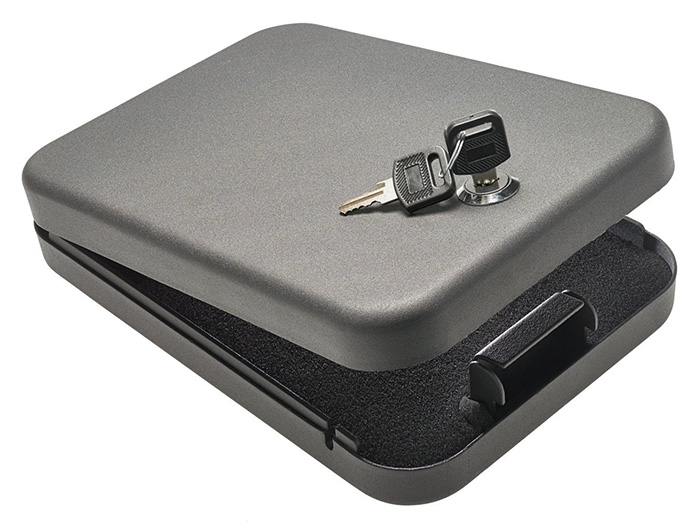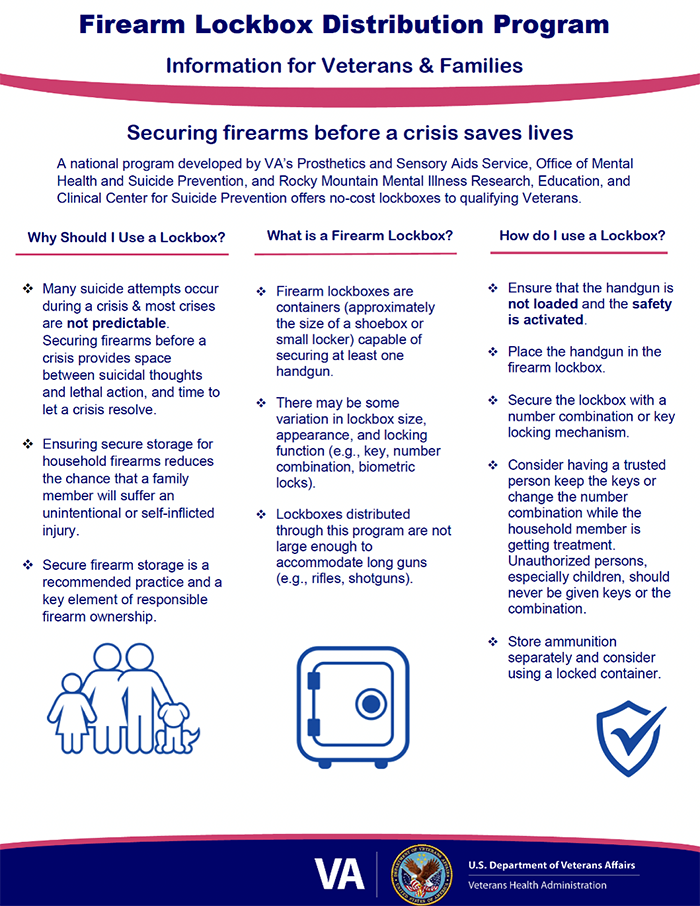Office of Research & Development |
 |


At-risk Veterans who choose to secure their firearms in a lockbox recognize the link between access to lethal means and suicide risk.
September 9, 2024
By Erica Sprey
VA Research Communications
"If someone can slow a Veteran's access to a firearm by even minutes, it might be enough for them to ask for help or to call the Veterans Crisis Line."
In 2021, more Americans died of gun-related injuries that any other year on record, with suicides accounting for more than half of those gun deaths. In that same year, 72% of Veteran suicides were by firearms, according to the 2023 National Veteran Suicide Prevention Annual Report. The firearm suicide rate among male Veterans was 62% greater than for non-Veteran men, and among Women Veterans, it was 281% greater than for non-Veteran women.
To address this issue, VA has mobilized a number of programs to help at-risk Veterans. One secure storage solution is a national initiative to prescribe a gun lockbox at no charge for qualifying at-risk Veterans who wish to receive one.
The program, which will formally launch in late 2024, is a collaboration between the Rocky Mountain Mental Illness Research, Education, and Clinical Center (MIRECC) for Suicide Prevention, VA National Prosthetics Service, and VA Office of Suicide Prevention.
A lockbox is a device that encloses a handgun and has some type of locking mechanism. It is relatively small in size—a rifle would not fit inside. For Veterans who decide to store their firearm this way, the intent is to increase the time it would take to access a lethal means in a time of crisis.
When Veterans are deemed to be at an elevated risk for suicide using the VA Comprehensive Suicide Risk Evaluation, and they have access to a handgun, VA clinicians will soon be able to prescribe a gun lockbox through the prosthetics order menu in VA’s electronic health record. There is no cost for Veterans to participate in the program and they will only receive a lockbox if they want one. This is the same process that clinicians use to order other medical devices, such as crutches or a glucometer.
Veterans have strong values regarding gun ownership that may be central to their experience as Veterans and crucial to the conversation of suicide prevention.
“Veterans understandably don’t want to be judged, and some may have concerns that their clinician is biased. In many cases, they are concerned that having conversations about gun ownership may affect their firearm rights,” said Dr. Joseph Simonetti, a physician who treats substance use disorders and is a suicide prevention researcher at the Rocky Mountain MIRECC in Aurora, Colorado.
Simonetti has been working with his colleagues to spread the word about the VA lockbox program. In his experience, conversations about secure storage and lockboxes are generally viewed favorably by Veterans. According to a JAMA Network study, about 80% of Veteran firearm owners agree that it is appropriate for a clinician to speak with a patient about firearms if they or someone in their family is at risk for suicide.
Often, conversations about secure firearm storage are more acceptable when family members or Veterans find themselves in crisis or are thinking about suicide, because they are more likely to recognize the link between access to lethal means and suicide risk, added Simonetti. The further away they get from a crisis, the more challenging it can be to encourage secure storage practices.
Women Veterans are at much greater risk for suicide by gun injury than their non-Veteran counterparts. In 2021, more than half of all suicides in Women Veterans were attributed to firearm injury.
“We should be shouting that from the rooftops, because there are many misconceptions about factors that contribute to suicide risk among women,” said Simonetti. “Firearms are now the leading method of suicide among Women Veterans.”
Researchers have yet to fully understand why rates of firearm suicide recently skyrocketed in Women Veterans, but VA researchers like Dr. Lindsey Monteith and her team at the Rocky Mountain MIRECC are working to understand Women Veterans’ perspectives on firearms and lethal means counseling.
Women Veterans are less likely to own firearms than Veteran men but are more likely to live in a home where firearms that belong to someone else are present. Through qualitative interviews, Monteith and her team have learned that Women Veterans’ perspectives on firearm ownership, storage, and access can be influenced by childhood experiences and the beliefs of intimate partners. For this reason, it is important to understand if and how other household members can be included in lethal means counseling discussions with Women Veterans.
Addressing Women Veterans’ use of firearms in suicide is essential to preventing suicide among them, said Monteith. That is why involving family members, healthcare providers, and other community members in suicide prevention is integral to the VA’s public health approach.
There is a general agreement that access to firearms doesn’t cause suicide, noted Simonetti. But it is one of the things that can increase suicide risk. If someone can slow a Veteran’s access to a firearm by even minutes, it might be enough for them to ask for help or to call the Veterans Crisis Line.
*If you’re a Veteran in crisis or concerned about one, contact the Veterans Crisis Line to receive 24/7 confidential support. You don't have to be enrolled in VA benefits or health care to connect. To reach responders, Dial 988 then Press 1, chat online at VeteransCrisisLine.net/Chat, or text 838255.

VA Research Currents archives || Sign up for VA Research updates